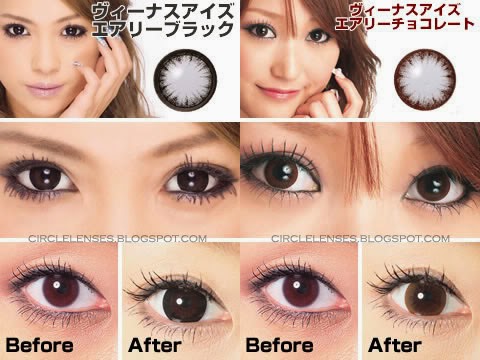Korea also pride themselves for their circle contact lens
(also known as big eye contact lens or simply circle lens); which helps the
iris appear much bigger in size. Such lenses help them in their pursuit of the
Ulzzang look, which places a lot of emphasis on big, shimmery eyes. They are
easily available in other Asian countries including Japan, Taiwan, China, and
Singapore for an affordable price. Not only so, such lenses are also available
in a wide variety of colours and effects, making one able to “decorate” their
eyes without going under the knife. Because of this, the primary use of such
contact lenses has already evolved into more of a fashion accessory or icon,
rather than as a medical device to correct astigmatism.
Above: Circle contact lens first originated in Korea, but are fast becoming popular in other parts of Asia, especially Japan. (Source: cookiesbeautyblog.blogspot.com)
Above: Circle lens are available in a wide variety of attractive colours.
(Source: geekgirlviews.wordpress.com)
Above: Screenshot of a forum discussion page Soompi whereby fans discuss their thoughts on circle lens.
Above: Global Pop star Lady Gaga is seen wearing circle contact lens in her Bad Romance music video. Circle contact lenses are not available in Western countries due to safety concerns and have to be imported. (Source: styleite.com)
Although doctors have expressed their concerns about the potential risks and safety issues of such lenses, many continue to turn a blind eye to it for the sake of beauty. Karen Riley, spokeswomen for the Food and Drug Administration, commented that “consumers risk significant eye injuries—even blindness”; while Dr. S. Barry Eiden, Chairman of the contact lens and cornea section of the American Optometric Association, describe such lenses as “encouraging the avoidance of professional care” (Saint Louis, 2010). Other concerns is that it may rob the eye of needed oxygen, reducing the optical quality of vision ( Hiraoka T, Okamoto F, Ishii Y, Oshika T, 2009).
Above: The American Optometric Association warns of the potential risks of circle lenses.
(Source: Youtube- AOA TV)




No comments:
Post a Comment